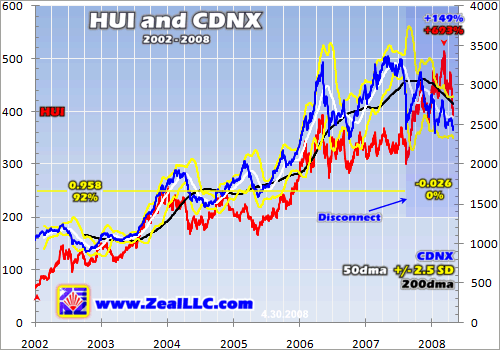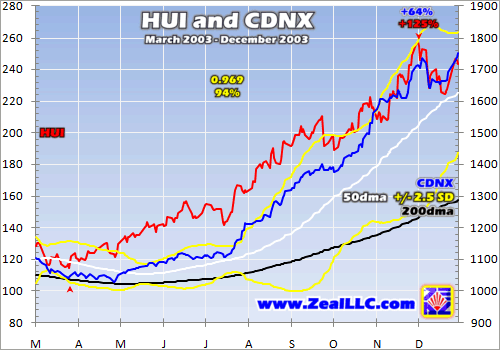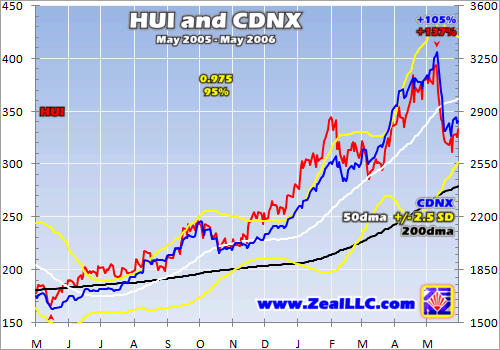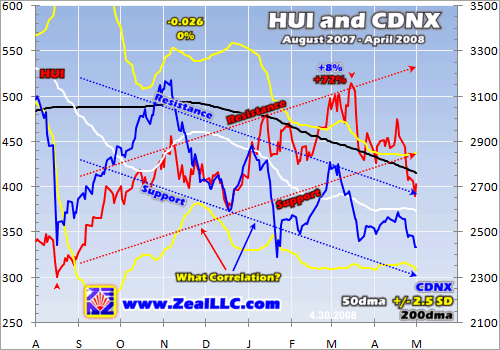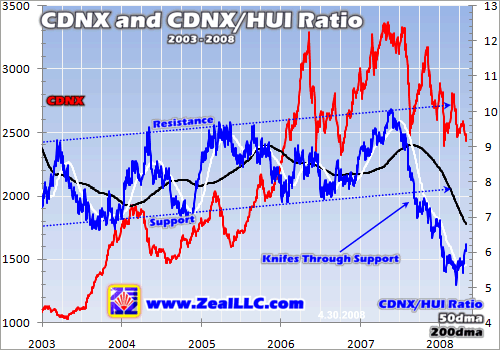|
|
|||||||
|
|
|
|
|
|
|
|
|
|
Junior Golds and CDNX Scott Wright May 2, 2008 2963 Words
While recent activity in the gold stock sector has caused many of its battle-hardened investors to capitulate, the tried and true speculators still holding strong in the junior-gold-stock realm are feeling beaten and bloodied.
As a speculator in junior gold stocks I have not been immune to the carnage in this small sector either. And itís not difficult to hear the wailing and gnashing of teeth. The juniors are in the midst of a fear-driven sentiment storm that is fierce and unforgiving.
When I wrote about juniors a month or so ago I extolled their virtues and presented a case for an impending rally. But even going into a seasonally strong time for gold and gold stocks, it has felt as though the markets have chewed up and spit out the juniors with incredulous distaste.
Stepping back and taking a look at this latest gold upleg it is apparent that gold stocks have been in a state of malaise. Even with gold rocketing higher through $800 and not taking a breath until it hit $1000, gold stocks have not been returning the type of positive leverage that their investors have grown accustomed to.
Based on past uplegs weíve been able to rationalize the lagging behavior of gold stocks to the performance of their underlying metal. After all, leverage does tend to increase toward the ends of uplegs when greed and euphoria grow rampant. Until recently fundamentals and technicals lined up for an end-of-upleg surge that had the potential to bring sweet redemption.
In anticipation of a gold stock rise investors have been able to use a number of metrics to monitor the greater gold stock environment. The XAU gold-stock index, the GDX gold miners ETF, and the venerable HUI gold-stock index are all vehicles that can serve this purpose.
These vehicles can be used mathematically to not only formulate performance figures but to plot charts allowing technical analysis. For example we can see that from the August 2007 lows to the March highs the HUI was up 72%. And we can also draw trend channels and plot moving averages to give us a visual compilation of past activity.
But no matter how much we slice, dice, and draw the HUI, junior gold stock speculators donít feel this gauges the performance of their class of stocks. Instead of trusting the HUI there is an overwhelming feeling that the juniors are underperforming. And speculators are feeling that their high-risk plays are the pariahs of the gold stock sector.
Unfortunately measured as a whole all these feelings are precisely this, feelings. As far as I know there is not a specific junior gold stock index in existence that measures the aggregate performance of the juniors. And this is of course understandable as a junior gold stock index would be very complex and difficult to manage.
While it is easy to look within your individual portfolio and see your handful of chosen juniors perhaps amplifying the losses of the major measuring sticks, it is very difficult to quantify this feeling of overall junior hatred. But even though there is not a specific measure of junior gold stocks, a vehicle does exist that can give us a pretty good tell on the activity of the overall junior constituency.
Most stock traders active in the commodities complex are familiar with the TSX Venture Exchange (TSX.V). Many folks consider the TSX.V to be the wild west of the stock markets. It is specifically designed to host an environment for junior companies to raise capital in the equity markets. And since this exchange resides in Canada, there is a proclivity for resources companies to populate the majority of the listings.
Like most exchanges around the world, the performance of the TSX.V can be measured on a real-time basis by an index. The symbol for this index is CDNX, which was an acronym for the former Canadian Venture Exchange. The full name of this index is the S&P/CDNX Composite Index and it is comprised of nearly 500 stocks while the exchange as a whole is home to thousands of stocks.
The genesis of the CDNX was a 1999 merger between the Vancouver and Alberta Stock Exchanges, becoming Canadaís sole exchange for the trading of junior equities. As Iím sure you can infer, the CDNX was subsequently gobbled up by the Toronto Stock Exchange (TSX), hence the name change to TSX.V.
Admittedly Iíve just passively followed the CDNX index over the years only to know it as the place where some of my favorite juniors reside. But with the junior distress of recent Iíve received some feedback from folks asking me to take a closer look at the CDNX and scrub it up against the HUI.
Well even though there are more than just gold stocks comprising this exchange I decided to humor this idea and have a look. And as you can see below, just a quick visual glance shows stunning similarity between the HUI and CDNX.
With CDNX daily data available through the end of 2001, when it was acquired by the TSX, we are able to plot a six-year chart to show these two indexes scrubbed up against each other. And just so this chart is free from distortion I zeroed all axes so we can compare the precise slopes.
Well with the movements of the CDNX so similar to those of the 15 biggest and best gold miners that comprise the HUI, I decided to take a closer look at what it is made of. And not surprisingly this junior equity index indeed has a mining bias. In fact mining companies heavily weight the CDNX.
According to the Toronto Stock Exchange, in 2007 it held 57% of the listings of the worldís public mining companies. Around 75% of these stocks are listed on the CDNX with the balance holding senior TSX listings. By my calculations mining companies comprise nearly 60% of the listings on the CDNX and hold about the equivalent market capitalization.
So let me now perform a little deductive reasoning here. Since the CDNX is a junior equity exchange, and since mining is its heaviest-weighted sector, and since gold is in fact the king of the metals and can be considered the driver of the mining stocks, is it too farfetched to deduce that the CDNX is indeed a good, not perfect, proxy for the performance of junior gold stocks? Perhaps! Letís take a closer look.
Well looking at this first chart you can see that from 2002 to around the middle of 2007 the HUI and CDNX moved near lockstep with each other. The CDNX of course didnít experience gains at the same magnitude as the HUI, but this is simply because its minor weightings in such sectors as technology, real estate, R&D, and other industries rounded the sharp moves of the mining stocks.
We then get to August 2007, the beginning of the latest upleg in gold, and see that there is a disconnect in the harmony that these two indexes shared. If we take a look at the mathematical correlation between the HUI and CDNX it tells quite a story.
From the beginning of 2002 up through the very day of the HUI low in August the HUI and CDNX ran a very tight correlation of 0.958 as indicated in yellow on the chart. This correlation returns an r-square of 92%, which means that 92% of the daily behavior of the CDNX can be explained by the daily behavior of the HUI.
But if you then run the correlation from August through today it is a completely different story. With a correlation of -0.026 and an r-square of 0%, the HUI and CDNX indexes appear to have ended their marriage. This is definitely alarming news for the junior camp, being that the CDNX is the one that has fallen off the tracks.
The startling revelation we get from our initial HUI and CDNX comparison now warrants us to drill down further. And in order to gain a firmer grasp on what we are seeing with the unprecedented lack of correlation in this latest upleg, it would behoove us to segment this thread of analysis down to an individual upleg level.
In comparing only the massive uplegs I will start with upleg 4 that ran from March 2003 through December 2003. Unfortunately I canít begin with upleg 2 because the CDNX data doesnít go far enough back in 2001, but uplegs 4 and 6 will paint enough of a picture.
Here we see excellent upleg 4 that saw the HUI rocket 125% higher with the CDNX sporting an impressive 64% gain of its own. Again the CDNX does not exhibit as sharp a gain as the HUI due to the diverse nature of its stocks as a whole. But within this index there were several individual junior gold stocks that had gains far greater than the HUIís.
And even more intriguing than the visual similarities between these two indexes is their correlation. Over this entire upleg the CDNX rode in stride with the HUI with a correlation of 0.969. This returned an r-square of an impressive 94%. In upleg 4 the juniors were mirroring the directional tendencies of the senior gold and silver stocks.
Next we take a look at how closely the CDNX followed the HUI over the course of massive upleg 6. And again at first glance we see near-parallel movements between these two indexes. In this upleg the HUI greatly rewarded gold stock traders by rising 137% before it reached its apex in May 2006. And the CDNX didnít do too shabby itself with a nice double over this same period of time.
As a junior-gold-stock proxy the CDNX performed as expected in upleg 6, it was highly correlated with the fortunes of the flagship HUI gold-stock index. The impressive correlation this time around was 0.975 with an r-square of 95%. The junior gold stocks were flying with the HUI and the elite explorers buried in the CDNX again greatly amplified the HUIís gains.
So as we came into our latest upleg, the junior gold stock speculators expected no less. With gold on the rise and the HUI even showing modest gains, CDNX history suggests that junior gold stocks should come along for the ride. But one look at this next chart puts fans on the flames of the trepidation that already haunts the junior-gold-stock sector.
Since the HUIís August low it has marched higher to the beat of what gold stock traders consider a slow-beating drum. Nevertheless it has trended higher and until just this week had nestled itself into an upward-sloping trend channel. So the CDNX should follow suit right? Provocatively this has not been the case at all!
While the HUI rose 72% trough to peak, the CDNX was only able to muster an 8% gain over this same span of time. In fact outside of its initial surge, the CDNX has actually been trending down in this latest upleg in both gold and the HUI. So if the CDNX is indeed a fair proxy for tracking junior gold stocks, then perhaps the feelings that speculators are having are righteous. Now that weíve zoomed in on the disconnect seen in the first chart, it is easy to see this lack of correlation.
Another way to view this disconnect is through the CDNX/HUI ratio (CHR). And the CHR is as simple as it sounds. The daily close of the CDNX is divided by the daily close of the HUI on a continuing basis. This resulting ratio is charted over time and shows the relative performance of the CDNX against the HUI.
Since the CDNX is the numerator, a rising CHR means junior gold stocks are outperforming the HUI. Conversely, a falling CHR means the HUI is outperforming the juniors. Looking at this chart you can see that since 2003 the CHR has been slowly rising on balance. But then it decided to break trend. And it broke trend in August 2007 of all places. Go figure!
The CHR shows us yet again that through the course of this entire upleg, the junior gold stocks have been underperforming not only gold but the HUI. Now in past uplegs we know that the juniors donít usually pick up steam until the latter half of an upleg as they are driven by capital from individual investors. But as seen by the CHR knifing through its secular support, things are different this time.
In the last five years the CHR had been bouncing between 7 and 10. But in August when it hit support just below 8, instead of bouncing it kept going lower. Now ratios can be driven by a combination of factors. For example both the HUI and CDNX can trend in the same strategic direction and result in a falling ratio. If the HUI is rising at a faster rate than the CNDX, or if the CDNX is falling at a more accelerated rate than the HUI, the CHR will trend down.
But this chart shows a more extreme scenario for the falling CHR. While the HUI has risen on balance the CDNX has fallen. And this has caused the CHR to plummet to levels nearly half what they were a year ago. So what does all this mean?
Well one common conclusion tossed around is it is no longer worth it to own the junior stocks. If the juniors canít perform at least at the same levels as the larger gold miners or even gold, then this argument is certainly logical. Whereas all gold stocks should have positive leverage to gold considering their individual company risks, the juniors should have even greater leverage due to their even higher degrees of riskiness.
So what has happened to cause these junior troubles? And why does sentiment appear to be worse now than ever before in the junior-gold-stock arena? Well there is certainly no change in the fundamentals. In fact junior gold explorers should be in demand now more than ever.
In the gold production lifecycle the exploration, discovery, and development phases are where the juniors play such a critical role. And with global gold production continuing to fall, the need for new mines to replace those with depleting resources is dire. Juniors exploring for gold should be highly sought after not only as acquisition targets for the senior miners but from investors looking to leverage their resources.
But odd is it may seem, even in an environment of $800+ gold the juniors are cast out as the lepers of the gold stocks. And this has been endlessly frustrating for a lot of folks. So much so that it has created a sentiment storm that continues to feed on itself and grow bigger. And this sentiment storm is overshadowing the stellar fundamentals for junior gold stocks. Provocatively I believe the second question above is a self-fulfilling prophecy for the first.
As an analyst I receive a lot of valuable feedback, both positive and negative. In recent months Iíve heard from individual traders running small trading lines all the way to hedge-fund managers. And sentiment is indeed rotten! A note from a long-time gold stock investor sums it all up:
ďWell here we are with the biggest run up in gold and silver in history. Yet in the last 8 months the juniors have gone sideways to downwards. This is like water torture! First it was just losing a penny here and a few cents there, but now I feel like Iíve missed out on this historic run up! This is making me mad and a little nuts!!! I keep thinking it will turn at a point for the juniors but the trend just never seems to change for themÖwhy havenít things worked this time around?Ē
This dialogue is actually tame compared to some of the feedback Iíve received. And Iíve heard from many folks that assure me they never plan on trading gold stocks again. The fear that is out there today is staggering! And now more than ever gold stocks are the consummate contrarian play.
Ultimately the pain junior-gold-stock speculators have endured since August has fed this storm to create a giant sentiment snowball that keeps getting bigger and bigger as it rolls down the hill. So far most traders are scattering from the path of this snowball not willing to fall victim to the carnage of the junior gold stocks.
But eventually this snowball will hit a wall and explode, and those speculators positioned in the elite juniors should win legendary gains. At Zeal we recently published a research report that includes detailed profiles of our favorite 12 junior gold stocks. These stocks are very fundamentally strong and when the junior fears subside they should outperform their peers.
To have the profiles of these 12 high-potential-for-success stocks at your fingertips please purchase this report today. And if you are looking for ongoing insight and analysis on these wild commodities markets, I invite you to join Zealís monthly newsletter service. Our cutting-edge research and trading strategies will help guide you through the exciting times we are in today.
The bottom line is the CDNX indeed represents a good proxy for the performance of the highly speculative junior gold stocks. In past uplegs the CDNX and HUI have had brilliant correlations, proving very compatible. But in this latest gold upleg that began in August a glaring disconnect has become apparent.
Without major fundamental flaws in gold and even the mining companies, it is evident that a fierce sentiment storm fed by fear has dominated the trading of these small stocks. But this storm will eventually pass, and when this happens gold stocks will once again shine. They are the ultimate deep contrarian play.
Scott Wright May 2, 2008 Subscribe |
|||||||
|
|
|
|
|
|
|
|
|
|
|
|
|
|
|
|||

